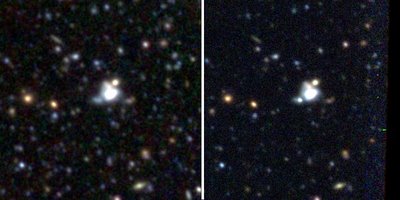Impossible supernova confounds astronomers

By Aussiegirl
Seeing the word "impossible" in the title of a scientific article is enough to make me stop what I'm doing, fire up a hot cup of mocha java, and settle in to discover just what these brilliant scientists find so impossible. What fun! It must be my inner anarchist!
Here's the description of the illustration: The supernova SNLS-03D3bb was discovered on April 24, 2003 in a small, young, star-forming galaxy, a satellite of the larger galaxy in this picture. Image on the left is before maximum brightness; at maximum brightness (right), the supernova was much brighter than its host.
Impossible supernova confounds astronomers (September 2006) - News - PhysicsWeb
Impossible supernova confounds astronomers
21 September 2006
Researchers in Canada have detected a highly unusual Type Ia supernova (SNLS-03D3bb) that is just over twice the usual brightness for such an event. The finding could cause experts to re-evaluate a fundamental measure that underpins our understanding of the universe’s expansion (Nature 443 308).
Type Ia supernovae occur when the mass of a white dwarf approaches the Chandrasekhar limit of 1.4 solar masses -- usually by the accretion of matter from a nearby star. These explosions usually have the same brightness and, as a result, serve as ‘standard candles’ for measuring distances in the Universe.
“We've found a supernova that is so bright that it ought to have been impossible,” University of Toronto astronomer Andy Howell, lead author of the study, told physicsweb.org. “Now we have to take a hard look at our theoretical understanding of Type Ia Supernovae and figure out how this could have happened.”
According to Howell, although it should not be possible for a white dwarf’s mass to break the Chandrasekhar limit, this event has shown that “nature has found a way”. The researchers estimate that such extreme events are rare, happening no more frequently than in 1 out of 500 supernova Ia events. However, the concern is that other supernovae, not as extreme as SNLS-03D3bb, could contaminate a large sample of blasts.
“We'd still get roughly the right measurements, but it might not be as precise as it could be; especially when it comes to determining the nature of the dark energy that is driving the acceleration of the universe,” said Howell. “Any knowledge of the extremes in which the ‘candles’ work and don't work will be essential for the kind of ultra-precise satellite missions that are being planned.”
The authors speculate that there are two possible explanations for the existence of the apparently massive white dwarf that lead to the explosion. The first is that the white dwarf was spinning rapidly, so that the outward centrifugal force prevented the star from collapsing in the usual manner. The second of these explanations suggest that the blast was the result of two smaller white dwarves merging, such that the body was briefly more massive than the Chandrasekhar limit before imploding.
The authors say that their results should not undermine the results obtained using supernovae as standard candles, such as with the discovery in 1998, by Saul Perlmutter from the Lawrence Berkeley National Laboratory and Alex Filippenko of the University of California, that the Universe’s expansion was accelerating. [....]


1 Comments:
what's that adidas tag-line: 'impossible is nothing'.
Post a Comment
<< Home